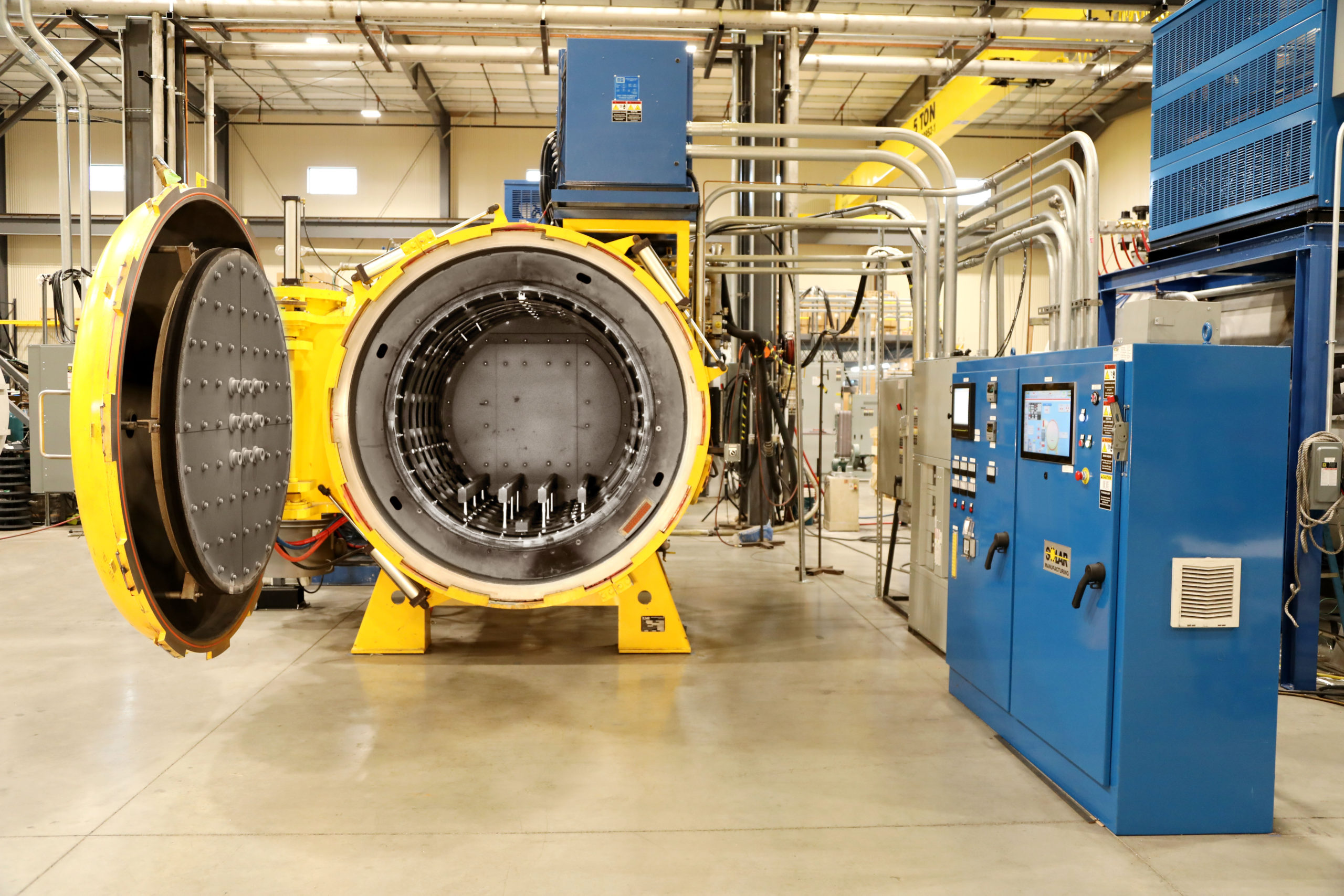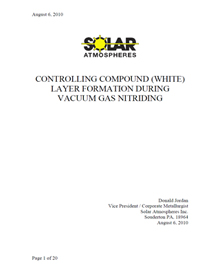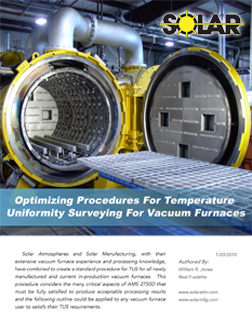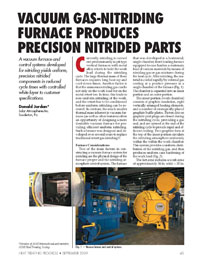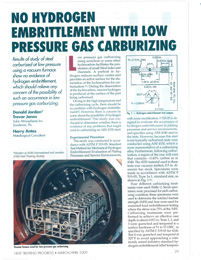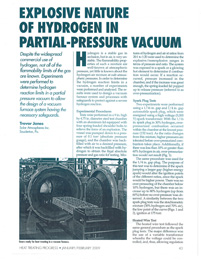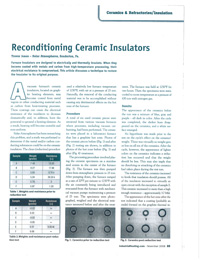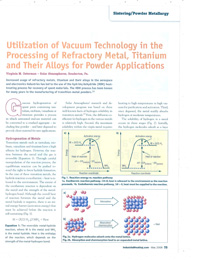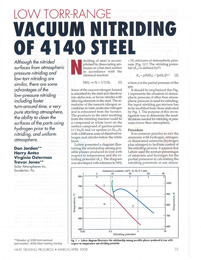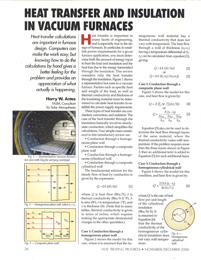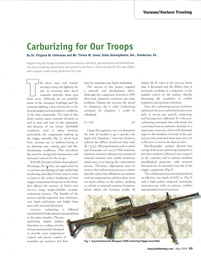CALL: 267-384-5040
Tech Downloads
Controlling Compound (White) Layer Formation During Vacuum Gas Nitriding
Solar Atmospheres has established a method of controlling the amount and depth of White layer resulting from Gas Nitriding. This procedure was accomplished following extensive testing using AISI 4140 Steel in a Solar Atmospheres Gas Nitriding Vacuum furnace. Various applications requiring Nitriding often require specific White layer limits which can now be provided by this process. Following an initial rapid pump down to produce an Oxygen free, vacuum environment, the Nitriding cycle consisted of a pre-heat at a partial pressure of Nitrogen followed by Nitriding at a slightly positive pressure using an Ammonia/Nitrogen mixture. Many cycles were performed varying the time and gas flow parameters at temperature and the resulting White layer composition and thickness determined. The key to controlling the White layer formation was the introduction of a Boost-Diffusion technique during the Nitriding phase. Surface hardness and depth of nitride zone were then recorded from microhardness measurements and metallography. All this data was compiled to establish Nitriding procedures that provide the final desired structure in the minimum cycle time. This includes processes that produce the minimum depth or complete absence of White layer as dictated by the final application of the parts.
Optimizing Procedures For Temperature Uniformity Surveying For Vacuum Furnaces
A Temperature Uniformity Survey ( TUS ) for a vacuum furnace to satisfy AMS 2750D must be performed using established procedures and methods that fully meet the requirements of the specification and allows for consistent and more accurate results of actual furnace capabilities. Solar Atmospheres and Solar Manufacturing, with their extensive vacuum furnace experience and processing knowledge, have combined to create a standard procedure for TUS for all newly manufactured and current in-production vacuum furnaces. This procedure considers the many critical aspects of AMS 2750D that must be fully satisfied to produce acceptable processing results and the following outline could be applied to any vacuum furnace user to satisfy their TUS requirements.
Vacuum Gas Nitriding Furnace Produces Precision Nitrided Parts
Currently, nitriding is carried out predominantly in pit type vertical furnaces with metal alloy retorts to hold the work load during the nitriding cycle. The large thermal mass of these furnaces requires long heat-up and cool-down times. Another factor is that the ammonia nitriding gas cracks not only on the work load but on the metal retort too. In time, this leads to non-uniform nitriding of the work, and the retort has to be conditioned before uniform nitriding can be restored. In contrast, the much smaller thermal mass inherent in vacuum furnaces (as well as other features) offers an opportunity of designing a more desirable vacuum furnace for providing efficient uniform nitriding. Such a furnace was designed and developed over several years to replace traditional retort gas nitriding.
No Hydrogen Embrittlement with Low Pressure Gas Carburizing
Results of study of steel carburized at low pressure using a vacuum furnace show no evidence of hydrogen embrittlement, which should relieve any concern of the possibility of such an occurrence in low pressure gas carburizing.
Explosive Nature of Hydrogen in Partial-Pressure Vacuum
Despite the widespread commercial use of hydrogen, not all of the flammability limits of the gas are known. Experiments were performed to determine hydrogen reaction limits in a partial pressure vacuum to allow the design of a vacuum furnace system having the necessary safeguar
Reconditioning Ceramic Insulators
Furnace insulators are designed to electrically and thermally insulate. When they become coated with metals and carbon from high-temperature processing, their electrical resistance is compromised. This article discusses a technique to restore the insulator to its original purpose.
Utilization of Vacuum Technology in the Processing of Refractory Metal, Titanium and their Alloys for Powder Applications
Increased usage of refractory metals, titanium and their alloys in the aerospace and electronics industries has led to the use of the hydride/dehydride (HDH) heat treating process for recovery of spent materials. The HDH process has been known for many years in the manufacturing of transition-metal powders.
Low Torr-Range Vacuum Nitriding of 4140 Steel
Although the nitrided surfaces from atmospheric pressure nitriding and low-torr nitriding are similar, there are some advantages of the low-pressure nitriding including faster turn-around time, a very pure starting atmosphere, the ability to clean the surfaces of the parts using hydrogen prior to the nitriding, and uniform atmosphere.
Heat Transfer and Insulation in Vacuum Furnaces
Heat transfer calculations are important in furnace design. Computers can make the work easy, but knowing how to do the calculations by hand gives a better feeling for the problem and provides an appreciation of what actually is happening.
Carburizing for Our Troops
Supporting our troops in times of war requires sacrifice, perseverance and innovation. The heat treating community was asked to perform a vital service for the war effort and vacuum carburizing answered the call.

